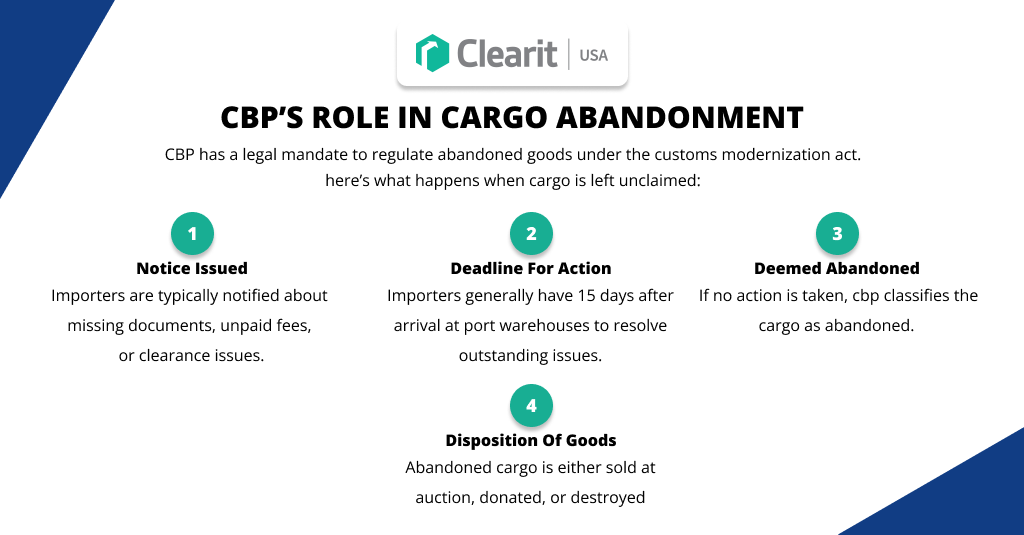When it comes to importing goods into the U.S., many businesses focus on tariffs, duties, and shipping delays, but one critical issue often gets overlooked: cargo abandonment. The U.S. Customs and Border Protection (CBP) has strict regulations for handling cargo that isn’t claimed, cleared, or properly processed. For importers, failing to address this issue can mean devastating financial and operational consequences.
In this blog, we’ll break down what cargo abandonment is, why it happens, how CBP handles it, and what steps importers can take to protect their shipments.

What Is Cargo Abandonment?
Cargo abandonment occurs when goods imported into the U.S. are left unclaimed, unpaid, or improperly documented, causing CBP or carriers to treat them as abandoned. This typically happens when:
- Duties, taxes, or fees remain unpaid.
- Documentation errors prevent clearance.
- Importers fail to respond to CBP notices.
- Logistics delays cause missed deadlines.
- The consignee rejects or refuses the shipment.
Once CBP categorizes cargo as abandoned, the goods can be seized, auctioned, or destroyed—leaving importers with zero recovery of their investment.

CBP’s Role in Cargo Abandonment
CBP has a legal mandate to regulate abandoned goods under the Customs Modernization Act. Here’s what happens when cargo is left unclaimed:
- Notice Issued – Importers are typically notified about missing documents, unpaid fees, or clearance issues.
- Deadline for Action – Importers generally have 15 days after arrival at port warehouses to resolve outstanding issues.
- Deemed Abandoned – If no action is taken, CBP classifies the cargo as abandoned.
- Disposition of Goods – Abandoned cargo is either sold at auction, donated, or destroyed.
This process protects U.S. trade security but can create huge losses for small and mid-sized businesses.
Why Cargo Gets Abandoned
Most importers don’t intend to abandon their cargo—but a few common issues often lead to it:
- Misunderstanding of Import Rules – Many businesses underestimate the complexity of U.S. customs procedures.
- Documentation Errors – Mistakes on invoices, packing lists, or entry filings delay clearance.
- Tariff and Duty Surprises – Unexpected costs discourage importers from paying and claiming goods. (Read more about hidden costs in our guide: The Hidden Costs of Importing for Small Businesses).
- Supply Chain Disruptions – Delays in international shipping can cause missed CBP deadlines.
- Financial Constraints – Some small businesses simply can’t pay unexpected duties and fees.
The High Cost of Ignoring Cargo Abandonment
Abandoning cargo doesn’t just mean losing goods—it can also lead to:
- Financial Losses – Total value of goods + shipping + duties already paid.
- Fines & Penalties – Importers may face additional costs from CBP or carriers.
- Damaged Relationships – Suppliers and logistics partners may see importers as unreliable.
- Compliance Red Flags – CBP may scrutinize future shipments more closely.
For e-commerce sellers and small businesses already dealing with tight margins, cargo abandonment can be a serious blow.
How Importers Can Prevent Cargo Abandonment
The good news: importers can take proactive steps to avoid cargo abandonment altogether.
1. Work with a Licensed Customs Broker
A customs broker ensures documentation is accurate, duties are calculated, and deadlines are met. Digital brokerage platforms like Clearit simplify this process for businesses of all sizes.
2. Plan for Tariffs and Duties
Unexpected tariffs are among the most common causes of cargo rejection. Stay ahead by understanding current U.S. trade policies, such as the 2025 U.S. Import Tariffs Guide.
3. Monitor Shipments in Real Time
Track cargo from departure to arrival. Many delays can be mitigated with proactive communication between suppliers, carriers, and brokers.
4. Respond Quickly to CBP Notices
If CBP flags an issue, time is critical. Delayed responses almost always result in abandoned goods.
5. Budget for Hidden Costs
Beyond tariffs, importers should be prepared for surcharges, warehousing fees, and penalties. (Check out our insights on tariff pass-through and inflation).
Looking Ahead: Cargo Abandonment in 2025 and Beyond
With increasing global trade and evolving U.S. tariff strategies, such as new U.S.–China tariffs, cargo abandonment risks are only rising. Importers who don’t adapt may see higher losses and disrupted supply chains.
The trend toward stricter enforcement by CBP means importers can’t afford to be reactive, they need proactive customs strategies.
Conclusion
Cargo abandonment is more than an inconvenience—it’s a business-critical risk that can wipe out profits and credibility. By understanding CBP rules, planning ahead for duties and tariffs, and working with an experienced customs broker, U.S. importers can safeguard their shipments and their bottom line.
Don’t let your cargo go to waste.
Partner with Clearit USA today for fast, reliable, and digital-first customs clearance, so your goods never get left behind.



